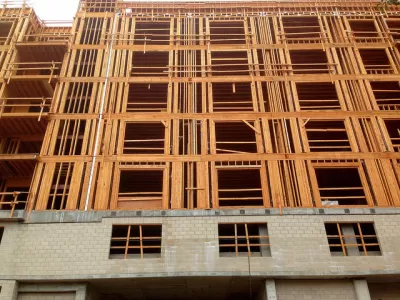In an era where cities all over the world are allowing larger and taller wood-framed buildings, the city of Sandy Springs just approved sweeping limitations on the construction practice.

"Over the objections of the wood products industry, the Sandy Springs City Council has approved a building code change to prohibit wood-framed construction for future buildings taller than three stories and larger than 100,000 square feet," reports David Ibata.
"Supporters of the change cited safety issues, as well as matters of quality, durability and longevity of buildings in turning to steel and masonry," according to Ibata. Objectors include the American Wood Council and Georgia Forestry Association.
Writing for Construction Dive, a construction industry newsletter, Kim Slowey surveys the world for examples of the construction industry finding new, larger-scale uses for wood construction. We at Planetizen have noted the example of Toronto, Ontario, which relaxed its wood-framed building standards to allow for buildings up to six stories high. Paris, France approved a wood-framed building that will reach 35 stories high back in 2015. The T3 project in Minneapolis targets a height of seven stories. The latter project is nearing completion, as is visible on its very own live feed construction camera.
Slowey finds examples from Stockholm, Sweden, and London, U.K, of approved projects that will push the boundaries of previous wood-framed buildings. In the United States, according to Slowey, the U.S. Department of Agriculture sponsored the U.S. Tall Wood Building Competition last year.
An article by Ely Portillo for The Charlotte Observer digs more into the implication of the actions of the Sandy Springs City Council by imagining the consequences if the city of Charlotte were to approve similar regulations. If the city of Charlotte instituted the same regulations, writes Portillo, it "would effectively exclude most of the new apartments under construction...except for uptown high rises built with concrete and steel."
FULL STORY: Sandy Springs bars wood framing in mid-rise construction

Maui's Vacation Rental Debate Turns Ugly
Verbal attacks, misinformation campaigns and fistfights plague a high-stakes debate to convert thousands of vacation rentals into long-term housing.

Planetizen Federal Action Tracker
A weekly monitor of how Trump’s orders and actions are impacting planners and planning in America.

San Francisco Suspends Traffic Calming Amidst Record Deaths
Citing “a challenging fiscal landscape,” the city will cease the program on the heels of 42 traffic deaths, including 24 pedestrians.

Defunct Pittsburgh Power Plant to Become Residential Tower
A decommissioned steam heat plant will be redeveloped into almost 100 affordable housing units.

Trump Prompts Restructuring of Transportation Research Board in “Unprecedented Overreach”
The TRB has eliminated more than half of its committees including those focused on climate, equity, and cities.

Amtrak Rolls Out New Orleans to Alabama “Mardi Gras” Train
The new service will operate morning and evening departures between Mobile and New Orleans.
Urban Design for Planners 1: Software Tools
This six-course series explores essential urban design concepts using open source software and equips planners with the tools they need to participate fully in the urban design process.
Planning for Universal Design
Learn the tools for implementing Universal Design in planning regulations.
Heyer Gruel & Associates PA
JM Goldson LLC
Custer County Colorado
City of Camden Redevelopment Agency
City of Astoria
Transportation Research & Education Center (TREC) at Portland State University
Jefferson Parish Government
Camden Redevelopment Agency
City of Claremont



























